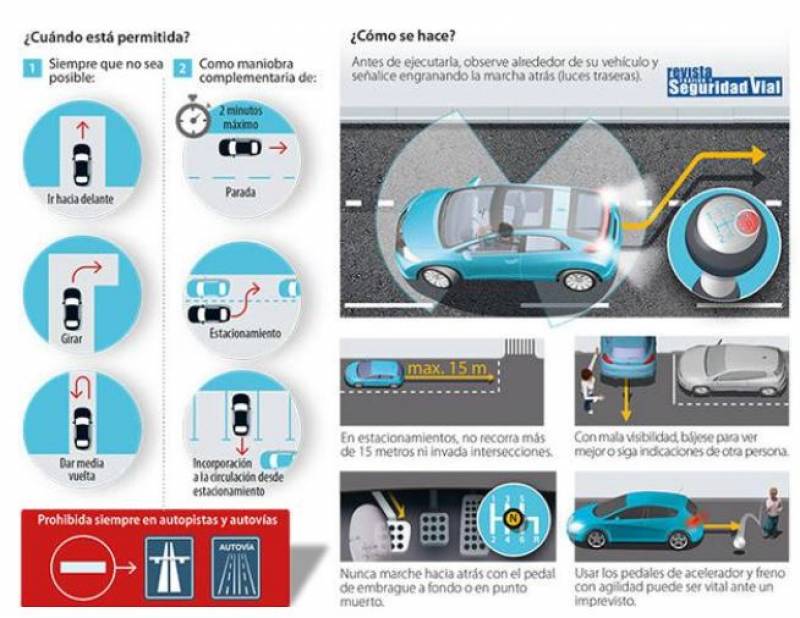- Region
- Vega baja
- Marina Alta
- Marina Baixa
- Alicante
- Baix Vinalopo
- Alto & Mitja Vinalopo
-
ALL TOWNS
- ALICANTE TOWNS
- Albatera
- Alfaz Del Pi
- Alicante City
- Alcoy
- Almoradi
- Benitatxell
- Bigastro
- Benferri
- Benidorm
- Calosa de Segura
- Calpe
- Catral
- Costa Blanca
- Cox
- Daya Vieja
- Denia
- Elche
- Elda
- Granja de Rocamora
- Guardamar del Segura
- Jacarilla
- Los Montesinos
- Orihuela
- Pedreguer
- Pilar de Horadada
- Playa Flamenca
- Quesada
- Rafal
- Redovan
- Rojales
- San Isidro
- Torrevieja
- Comunidad Valenciana
article_detail
These are the only times drivers are allowed to reverse their cars on Spanish roads
Reversing a vehicle is a dangerous practice and is prohibited in most cases throughout Spain

Backing into a tight parking space or avoiding an obstruction on the road often necessitates the manoeuvre of reversing but in Spain, driving backwards is considered highly dangerous and banned in most cases. According to the General Directorate of Traffic (DGT), reversing is very strictly regulated so it’s important to know when you can and can’t back up your car to avoid falling foul of the law.
The Traffic and Road Safety legislation specifies that drivers are allowed to reverse "when it is not possible to go forward or change direction or direction of travel and as a complementary manoeuvre to others."
This essentially means that motorists can drive in reverse in order to make a stop, park or join traffic, once the backing-up distance doesn’t exceed 15 metres or involve driving over a crossroads. In addition, the traffic authorities specify that reversing must be carried out slowly with correct signalling. And, of course, motorists should never drive backwards if the manoeuvre will put other road users at risk.
 On motorways and dual carriageways, high capacity roads on which cars travel much faster, reversing is strictly prohibited. It’s considered a serious offence and flouters will face hefty fines and have several points removed from their licences. On these busier thoroughfares, only drivers of priority vehicles such as the police, Guardia Civil, firefighters and ambulances are allowed to back up and even then, only in exceptional circumstances where it can’t be avoided.
On motorways and dual carriageways, high capacity roads on which cars travel much faster, reversing is strictly prohibited. It’s considered a serious offence and flouters will face hefty fines and have several points removed from their licences. On these busier thoroughfares, only drivers of priority vehicles such as the police, Guardia Civil, firefighters and ambulances are allowed to back up and even then, only in exceptional circumstances where it can’t be avoided.The RSM rule
Even in cases where reversing is permitted, the DGT advises drivers to follow the RSM rule:
- Rearview mirror: check that it’s safe to reverse as often as necessary.
- Signal: Always indicate the direction of travel so as not to catch other road users off guard.
- Manoeuvre: only put the car into reverse after following the previous two steps.
Find all the latest motoring and travel news here or join our Driving in Spain Facebook group for regular updates
Image 1: Freepik
Image 2: DGT
staff.inc.ali
Loading
Sign up for the Spanish News Today Editors Roundup Weekly Bulletin and get an email with all the week’s news straight to your inbox
Special offer: Subscribe now for 25% off (36.95 euros for 48 Bulletins)
OR
you can sign up to our FREE weekly roundup!
Read some of our recent bulletins:
Discount Special Offer subscription:
36.95€ for 48 Editor’s Weekly News Roundup bulletins!
Please CLICK THE BUTTON to subscribe.
(List price 3 months 12 Bulletins)
Read more stories from around Spain:
Contact Murcia Today: Editorial 000 000 000 /
Office 000 000 000

















